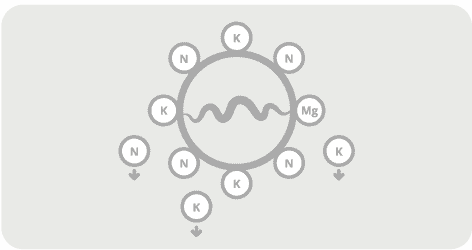

How glomalin and its effect on the clay-humus complex enhance the increase of fertilizer storage capacity
We have seen that humus is formed on the surface of the soil and that clay is formed at depth. Now let’s see how these 2 elements combine to form the clay-oil complex (clay-humic complex).
Humus plays a major role in the formation of aggregates, which, together with the colloidal fraction of soil clay and substances such as carbonates, iron oxides, aluminium oxides and silica, are the three main categories of materials that cause aggregation. At the same time, however, there is humus binding by the mechanical fraction of the clay and formation of the clay-humic complex.
Scharpenseel mentions three mechanisms to explain the attachment of organic components to clay.
With multivalent cation bridges: they bond negatively charged inorganic (clay) and organic colloids. It is mainly to this mechanism that the association of humus and montmorillonite is due.
Single bonds: they bind negatively charged organic components to the building blocks of clay minerals. Active sites of the latter include -O, -OH, -AI-OH, FeOH, Si-OH and exchangeable cation sites, while in the humus we have -NH3, -SH, -OH kai -COOH. Kaolinitic-type minerals are thus combined in this way with humus.
By van der Waals forces: by entropy forces or by displacements of dipolar electric charges, organic molecules, without electric charge and with a molecular weight greater than 150, are joined in the crystals of clay. This coalescence process usually coexists with the other mechanisms.
The large earthworms of the tolerant fauna ingest organic matter at the soil surface every night and then dig vertical tunnels to search for clay at depth. They then rise to the surface of the soil to deposit the contents of their digestive tract, forming excrement called casts.
It is in the gut of these earthworms that the clay and humus meet to form the clay-humic complex. The two elements of this complex are connected by calcium ions that have two positive charges, negative clay and humus. To do this, earthworms have a gland called the Morren gland, which secretes a lot of calcium. Some beneficial soil fungi will then secrete a humic adhesive called glomalin into this complex, which serves as a binder between the clay and humus, necessary for fixing the clay-humic complex.

This is why when you put a plaster in a jar of water, you notice that it does not collapse.
On the other hand, if we take soil consisting of clay and separate humus, we observe a dissolved deposit at the bottom of the jar. The earthworm cast does not move because it is a perfectly stable aluminium-humic complex, bound with glomalin.
This clay-humic complex formed in this way will allow the retention (storage) of the mineral elements that are susceptible to leaching so that they remain attached through bonds formed at the level of the outer surface of the clay sheets, but also between and among their edges and eventually assimilated by the plants.
To maintain this balance, earthworms and beneficial microorganisms must be kept in the soil, in particular through the farming techniques used in so-called conservation agriculture.
Based on this principle Terrabiotec products for soil application such as :
- Granular Terra Mineral, Terra Crop, Terra Crop, Terra
- Myco etc,
- the Terra Mineral microgranules,
- the water-soluble Terra First and Terra Myco
- as well as the liquids Terra Flow
contains technology (as one of the 6 technologies) that promotes a very well-formed clay-humic complex that retains the elements essential for plant growth by preventing leaching and making them available to the root system of the plant, limiting losses compared to common fertilizers.



